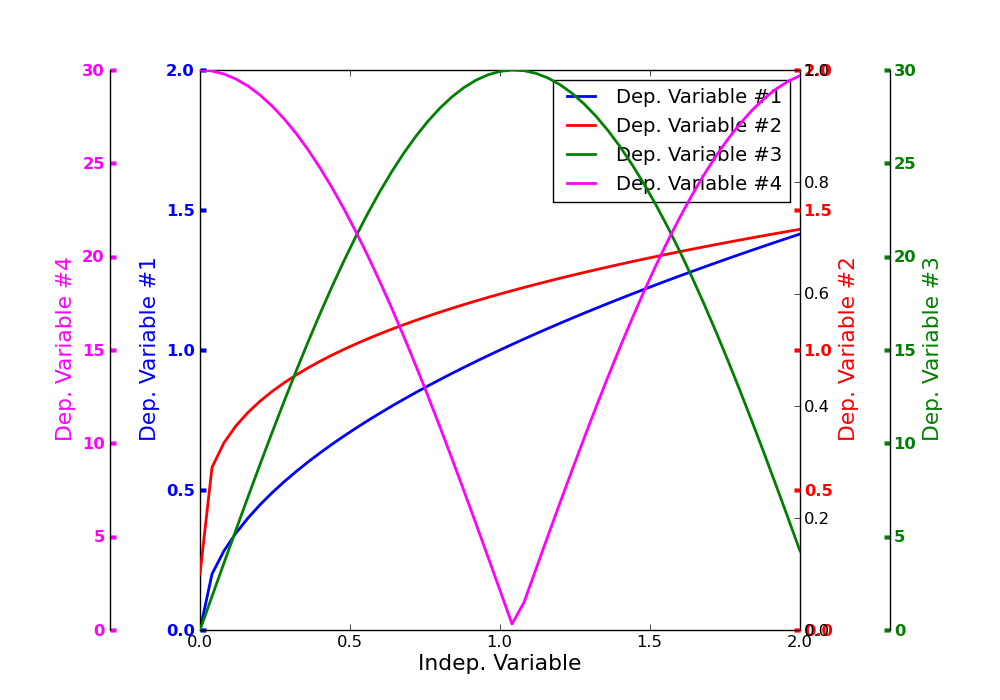# Dr. Phillip M. Feldman, 27 Oct, 2009
···
#
examples/pylab_examples/multiple_yaxis_with_spines.py?revision=7908&view=markup
# Section 1: Import modules, define functions, and allocate storage.
import matplotlib.pyplot as plt
from numpy import *
def make_patch_spines_invisible(ax):
ax.set_frame_on(True)
ax.patch.set_visible(False)
for sp in ax.spines.itervalues():
sp.set_visible(False)
def make_spine_invisible(ax, direction):
if direction in ["right", "left"]:
ax.yaxis.set_ticks_position(direction)
ax.yaxis.set_label_position(direction)
elif direction in ["top", "bottom"]:
ax.xaxis.set_ticks_position(direction)
ax.xaxis.set_label_position(direction)
else:
raise ValueError("Unknown Direction : %s" % (direction,))
ax.spines[direction].set_visible(True)
# Create list to store dependent variable data:
y= [0, 0, 0, 0, 0]
# Section 2: Define names of variables and the data to be plotted.
# `labels` stores the names of the independent and dependent variables).
The
# first (zeroth) item in the list is the x-axis label; remaining labels are
the
# first y-axis label, second y-axis label, and so on. There must be at
least
# two dependent variables and not more than four.
labels= ['Indep. Variable', 'Dep. Variable #1', 'Dep. Variable #2',
'Dep. Variable #3', 'Dep. Variable #4']
# Plug in your data here, or code equations to generate the data if you wish
to
# plot mathematical functions. x stores values of the independent variable;
# y[1], y[2], ... store values of the dependent variable. (y[0] is not
used).
# All of these objects should be NumPy arrays.
# If you are plotting mathematical functions, you will probably want an
array of
# uniformly spaced values of x; such an array can be created using the
# `linspace` function. For example, to define x as an array of 51 values
# uniformly spaced between 0 and 2, use the following command:
# x= linspace(0., 2., 51)
# Here is an example of 6 experimentally measured y1-values:
# y[1]= array( [3, 2.5, 7.3e4, 4, 8, 3] )
# Note that the above statement requires both parentheses and square
brackets.
# With a bit of work, one could make this program read the data from a text
file
# or Excel worksheet.
# Independent variable:
x = linspace(0., 2., 51)
# First dependent variable:
y[1]= sqrt(x)
# Second dependent variable:
y[2]= 0.2 + x**0.3
y[3]= 30.*sin(1.5*x)
y[4]= 30.*abs(cos(1.5*x))
# Set line colors here; each color can be specified using a single-letter
color
# identifier ('b'= blue, 'r'= red, 'g'= green, 'k'= black, 'y'= yellow,
# 'm'= magenta, 'y'= yellow), an RGB tuple, or almost any standard English
color
# name written without spaces, e.g., 'darkred'. The first element of this
list
# is not used.
colors= [' ', 'b', 'darkred', 'g', 'magenta']
# Set the line width here. linewidth=2 is recommended.
linewidth= 2
# Section 3: Generate the plot.
N_dependents= len(labels) - 1
if N_dependents > 4: raise Exception, \
'This code currently handles a maximum of four independent variables.'
# Open a new figure window, setting the size to 10-by-7 inches and the
facecolor
# to white:
fig= plt.figure(figsize=(10,7), dpi=120, facecolor=[1,1,1])
host= fig.add_subplot(111)
host.set_xlabel(labels[0])
# Use twinx() to create extra axes for all dependent variables except the
first
# (we get the first as part of the host axes). The first element of y_axis
is
# not used.
y_axis= (N_dependents+2) * [0]
y_axis[1]= host
for i in range(2,len(labels)+1): y_axis[i]= host.twinx()
if N_dependents >= 3:
# The following statement positions the third y-axis to the right of the
# frame, with the space between the frame and the axis controlled by the
# numerical argument to set_position; this value should be between 1.10
and
# 1.2.
y_axis[3].spines["right"].set_position(("axes", 1.15))
make_patch_spines_invisible(y_axis[3])
make_spine_invisible(y_axis[3], "right")
plt.subplots_adjust(left=0.0, right=0.8)
if N_dependents >= 4:
# The following statement positions the fourth y-axis to the left of the
# frame, with the space between the frame and the axis controlled by the
# numerical argument to set_position; this value should be between 1.10
and
# 1.2.
y_axis[4].spines["left"].set_position(("axes", -0.15))
make_patch_spines_invisible(y_axis[4])
make_spine_invisible(y_axis[4], "left")
plt.subplots_adjust(left=0.2, right=0.8)
p= (N_dependents+1) * [0]
# Plot the curves:
for i in range(1,N_dependents+1):
p[i], = y_axis[i].plot(x, y[i], colors[i],
linewidth=linewidth, label=labels[i])
# Set axis limits. Use ceil() to force upper y-axis limits to be round
numbers.
host.set_xlim(x.min(), x.max())
host.set_xlabel(labels[0], size=16)
for i in range(1,N_dependents+1):
y_axis[i].set_ylim(0.0, ceil(y[i].max()))
y_axis[i].set_ylabel(labels[i], size=16)
y_axis[i].yaxis.label.set_color(colors[i])
for obj in y_axis[i].yaxis.get_ticklines():
# `obj` is a matplotlib.lines.Line2D instance
obj.set_color(colors[i])
obj.set_markeredgewidth(3)
for obj in y_axis[i].yaxis.get_ticklabels():
obj.set_color(colors[i])
obj.set_size(12)
obj.set_weight(600)
# To get rid of the legend, comment out the following two lines:
lines= p[1:]
host.legend(lines, [l.get_label() for l in lines])
plt.draw(); plt.show()
–
View this message in context: http://www.nabble.com/Possible-to-get-four-y-axes-on-a-single-plot--tp26041500p26088240.html
Sent from the matplotlib - users mailing list archive at Nabble.com.
